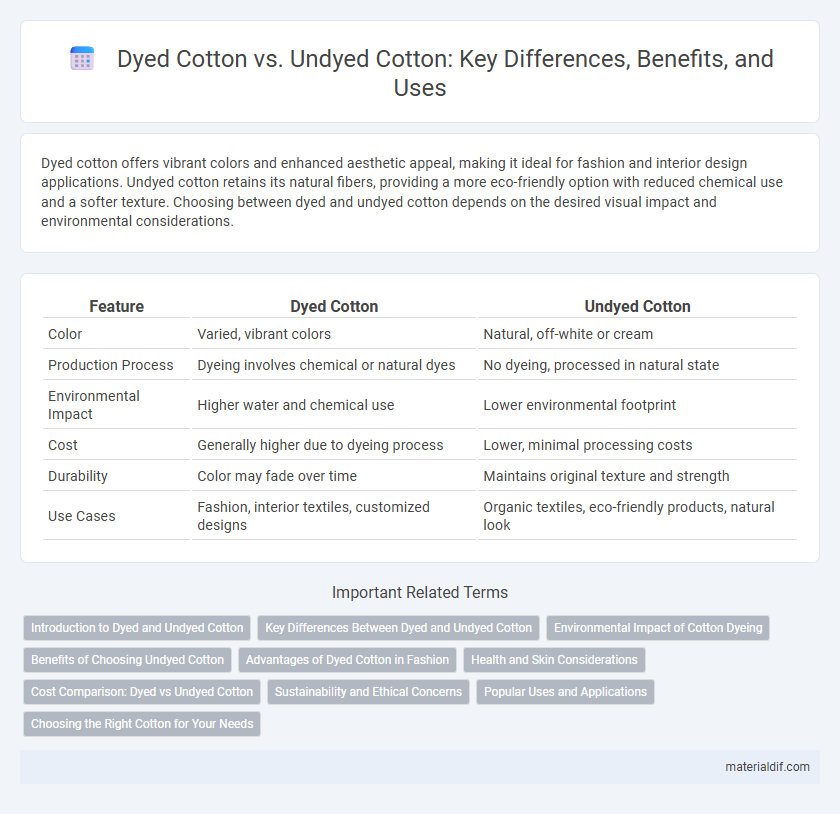Dyed cotton offers vibrant colors and enhanced aesthetic appeal, making it ideal for fashion and interior design applications. Undyed cotton retains its natural fibers, providing a more eco-friendly option with reduced chemical use and a softer texture. Choosing between dyed and undyed cotton depends on the desired visual impact and environmental considerations.
Table of Comparison
| Feature | Dyed Cotton | Undyed Cotton |
|---|---|---|
| Color | Varied, vibrant colors | Natural, off-white or cream |
| Production Process | Dyeing involves chemical or natural dyes | No dyeing, processed in natural state |
| Environmental Impact | Higher water and chemical use | Lower environmental footprint |
| Cost | Generally higher due to dyeing process | Lower, minimal processing costs |
| Durability | Color may fade over time | Maintains original texture and strength |
| Use Cases | Fashion, interior textiles, customized designs | Organic textiles, eco-friendly products, natural look |
Introduction to Dyed and Undyed Cotton
Dyed cotton features fibers treated with colorants to enhance aesthetic appeal and customize fabric appearance, while undyed cotton retains its natural, off-white or cream color. The dyeing process involves either fiber, yarn, or fabric level coloration, influencing the cotton's texture, durability, and environmental impact. Undyed cotton emphasizes purity and sustainability, often preferred for hypoallergenic and eco-friendly textile products.
Key Differences Between Dyed and Undyed Cotton
Dyed cotton undergoes a coloring process where pigments or dyes are absorbed into the cotton fibers, resulting in vibrant hues and patterns, whereas undyed cotton retains its natural, off-white or cream color without any chemical treatment. Dyed cotton offers more versatility in fashion and design due to a wide range of color options, while undyed cotton is prized for its organic and eco-friendly appeal, often used in sustainable textile products. The dyeing process can impact the fabric's texture and durability, with dyed cotton sometimes experiencing slight weakening or color fading over time compared to the more durable, untreated fibers of undyed cotton.
Environmental Impact of Cotton Dyeing
Dyed cotton significantly increases water consumption and chemical pollution compared to undyed cotton, which remains untreated and environmentally friendlier. The dyeing process releases toxic substances into waterways, contributing to water contamination and ecosystem damage. Choosing undyed cotton reduces the ecological footprint by minimizing the use of harmful dyes and water resources.
Benefits of Choosing Undyed Cotton
Undyed cotton retains its natural fibers, offering superior breathability and softness compared to dyed cotton, which often involves chemical treatments that can weaken fabric quality. Choosing undyed cotton reduces environmental impact by minimizing water usage and eliminating harmful dye pollutants. This eco-friendly option supports sustainable agriculture and provides hypoallergenic benefits ideal for sensitive skin.
Advantages of Dyed Cotton in Fashion
Dyed cotton offers vibrant color options that enhance fashion design versatility and enable seasonal trend adaptation. It provides improved aesthetic appeal, allowing designers to create unique patterns and bold styles that attract consumers. The dyeing process also often adds a layer of softness and durability to the fabric, increasing the garment's overall quality and wearability.
Health and Skin Considerations
Dyed cotton fabrics often contain synthetic dyes and chemical mordants that can cause skin irritation, allergic reactions, or exacerbate conditions like eczema, especially for sensitive skin types. Undyed, natural cotton is hypoallergenic, breathable, and free from potentially harmful additives, making it a safer choice for individuals prone to dermatitis or other skin sensitivities. Choosing undyed cotton reduces exposure to toxins, promoting healthier skin and overall comfort.
Cost Comparison: Dyed vs Undyed Cotton
Dyed cotton generally incurs higher costs than undyed cotton due to additional expenses in dye materials, labor, and environmental treatments required for color fixation and wastewater management. Undyed cotton is more economical, benefiting from fewer processing steps, which reduces energy consumption and chemical use. Price differences vary based on dye type, fabric quality, and production scale, influencing the final market price for textile manufacturers and consumers.
Sustainability and Ethical Concerns
Dyed cotton often involves the use of synthetic chemicals and large volumes of water, raising significant sustainability concerns due to pollution and resource depletion. Undyed cotton, particularly when sourced organically, reduces environmental impact by avoiding harmful dyes and minimizing chemical use, promoting soil health and biodiversity. Ethically, undyed cotton supports fair labor practices by simplifying production processes and lessening exposure to toxic substances for workers.
Popular Uses and Applications
Dyed cotton is widely used in fashion and home textiles due to its vibrant colors and ability to match specific design palettes, making it ideal for clothing, upholstery, and curtains. Undyed cotton, valued for its natural, eco-friendly qualities, is popular in organic clothing, baby products, and reusable bags, appealing to consumers prioritizing sustainability. Both forms are essential in textile manufacturing, with dyed cotton favored for aesthetic variety and undyed cotton preferred for environmentally conscious applications.
Choosing the Right Cotton for Your Needs
Dyed cotton offers vibrant colors and patterns that enhance the aesthetic appeal of textiles, making it ideal for fashion and home decor projects requiring specific hues. Undyed cotton retains its natural fibers and softness, providing a hypoallergenic, eco-friendly option favored for sensitive skin and sustainable products. Selecting between dyed and undyed cotton depends on priorities such as color preference, environmental impact, and fabric texture requirements.
Dyed Cotton vs Undyed Cotton Infographic

 materialdif.com
materialdif.com